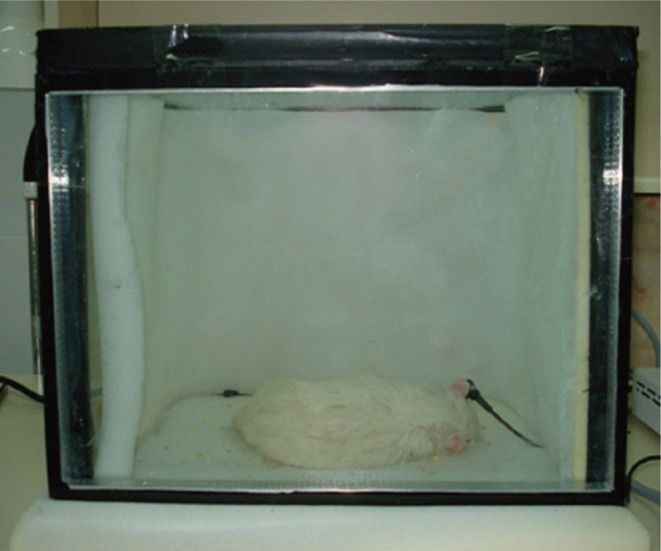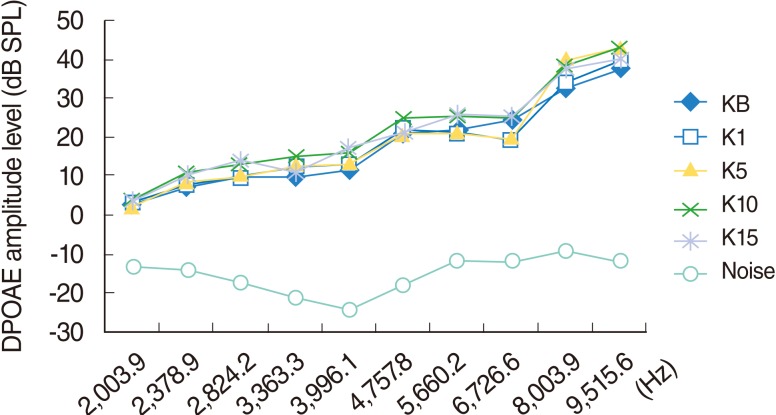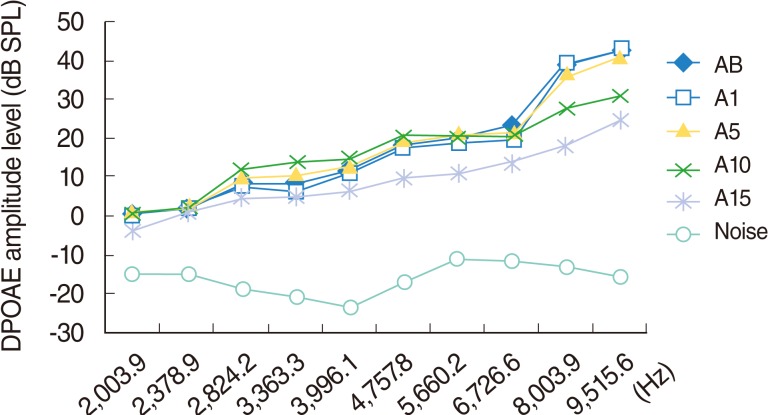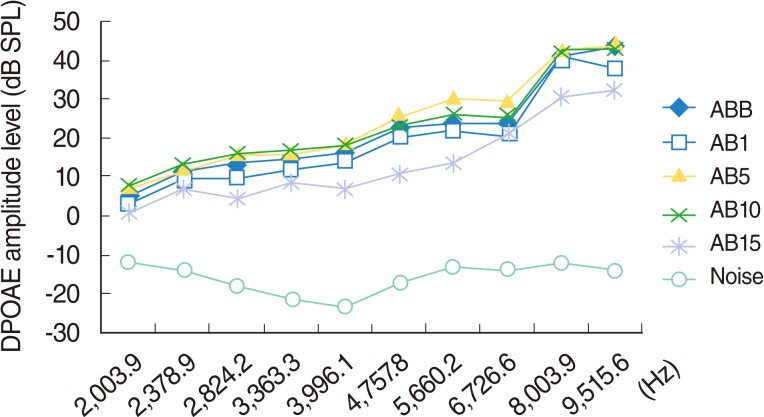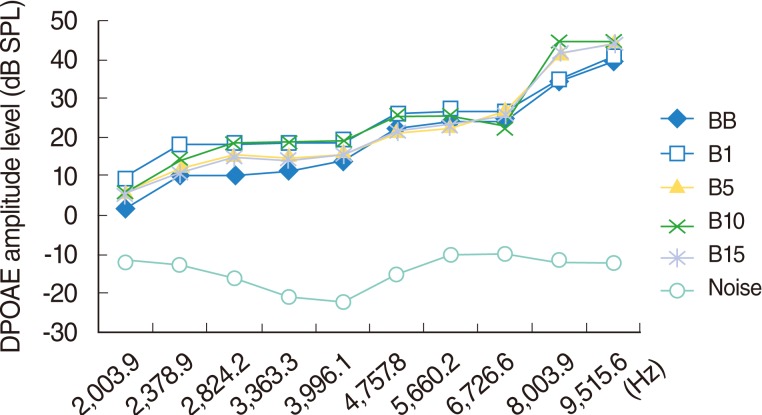Clin Exp Otorhinolaryngol.
2013 Mar;6(1):1-6.
Evaluation of the Protective Effect of Beta Glucan on Amikacin Ototoxicity Using Distortion Product Otoacoustic Emission Measurements in Rats
- Affiliations
-
- 1Department of Otorhinolaryngology, Inonu University Medical Faculty, Malatya, Turkey.
- 2Department of Pharmacology, Istanbul Medeniyet University Medical Faculty, Istanbul, Turkey.
- 3Department of Otorhinolaryngology, Istanbul Medeniyet University Medical Faculty, Istanbul, Turkey. mtkalcioglu@hotmail.com
Abstract
OBJECTIVES
This experimental study investigated the possible protective effect of beta glucans on amikacin ototoxicity.
METHODS
Thirty-eight rats with normal distortion product otoacoustic emissions (DPOAEs) were divided into four groups. Group K was the control group. Group A was injected intramuscularly (i.m.) with amikacin 600 mg/kg/day between days 1-15. Group AB was given beta glucan gavage 1 mg/kg/day on days 0-15 and given amikacin 600 mg/kg/day i.m. on days 1-15. Group B was administered only beta glucan gavage, 1 mg/kg/day, on days 0-15. The DPOAEs were elicited in different frequency regions between 2,003 and 9,515 Hz, as distortion product diagrams (DPgrams), before and after the medication was administered, in all groups, on days 1, 5, 10, and 15.
RESULTS
No significant changes in the DPgrams were observed in group K. In group A, significant deterioration was observed at the 8,003 and 9,515 Hz frequencies on day 10, and at the 3,991, 4,557, 5,660, 6,726, 8,003, and 9,515 Hz frequencies on day 15. For group AB, statistically significant deterioration was observed at the 2,824, 8,003, and 9,515 Hz frequencies on day 15. The results for group B showed a significant improvement of hearing at the 2,378, 2,824, 3,363, and 3,991 Hz frequencies on day 1, at the 3,363, 3,991, and 8,003 Hz frequencies on day 10, and at the 8,003 Hz frequency on day 15.
CONCLUSION
This study suggests that amikacin-induced hearing loss in rats may be limited to some extent by concomitant use of beta glucan.
Figure
Reference
-
1. Priuska EM, Schacht J. Mechanism and prevention of aminoglycoside ototoxicity: outer hair cells as targets and tools. Ear Nose Throat J. 1997; 3. 76(3):164–171. PMID: 9086645.
Article2. Roland PS. Characteristics of systemic and topical agents implicated in toxicity of the middle and inner ear. Ear Nose Throat J. 2003; 1. 82(Suppl 1):3–8. PMID: 12610886.
Article3. Rizzi MD, Hirose K. Aminoglycoside ototoxicity. Curr Opin Otolaryngol Head Neck Surg. 2007; 10. 15(5):352–357. PMID: 17823553.
Article4. Dai CF, Mangiardi D, Cotanche DA, Steyger PS. Uptake of fluorescent gentamicin by vertebrate sensory cells in vivo. Hear Res. 2006; 3. 213(1-2):64–78. PMID: 16466873.
Article5. Tran Ba Huy P, Bernard P, Schacht J. Kinetics of gentamicin uptake and release in the rat: comparison of inner ear tissues and fluids with other organs. J Clin Invest. 1986; 5. 77(5):1492–1500. PMID: 3700652.
Article6. Dulon D, Hiel H, Aurousseau C, Erre JP, Aran JM. Pharmacokinetics of gentamicin in the sensory hair cells of the organ of Corti: rapid uptake and long term persistence. C R Acad Sci III. 1993; 7. 316(7):682–687. PMID: 8019890.7. Hashino E, Shero M. Endocytosis of aminoglycoside antibiotics in sensory hair cells. Brain Res. 1995; 12. 704(1):135–140. PMID: 8750975.
Article8. Marcotti W, van Netten SM, Kros CJ. The aminoglycoside antibiotic dihydrostreptomycin rapidly enters mouse outer hair cells through the mechano-electrical transducer channels. J Physiol. 2005; 9. 567(Pt 2):505–521. PMID: 15994187.9. Hirose K, Westrum LE, Stone JS, Zirpel L, Rubel EW. Dynamic studies of ototoxicity in mature avian auditory epithelium. Ann N Y Acad Sci. 1999; 11. 884:389–409. PMID: 10842609.
Article10. Hirose K, Hockenbery DM, Rubel EW. Reactive oxygen species in chick hair cells after gentamicin exposure in vitro. Hear Res. 1997; 2. 104(1-2):1–14. PMID: 9119753.
Article11. Lopez-Gonzalez MA, Delgado F, Lucas M. Aminoglycosides activate oxygen metabolites production in the cochlea of mature and developing rats. Hear Res. 1999; 10. 136(1-2):165–168. PMID: 10511636.
Article12. Priuska EM, Schacht J. Formation of free radicals by gentamicin and iron and evidence for an iron/gentamicin complex. Biochem Pharmacol. 1995; 11. 50(11):1749–1752. PMID: 8615852.
Article13. Wu WJ, Sha SH, Schacht J. Recent advances in understanding aminoglycoside ototoxicity and its prevention. Audiol Neurootol. 2002; May-Jun. 7(3):171–174. PMID: 12053140.
Article14. Ross GD, Vetvicka V, Yan J, Xia Y, Vetvickova J. Therapeutic intervention with complement and beta-glucan in cancer. Immunopharmacology. 1999; 5. 42(1-3):61–74. PMID: 10408367.15. Lee KY, Lee MH, Chang IY, Yoon SP, Lim DY, Jeon YJ. Macrophage activation by polysaccharide fraction isolated from Salicornia herbacea. J Ethnopharmacol. 2006; 2. 103(3):372–378. PMID: 16183225.
Article16. Kim MK, Lee IY, Ko JH, Rhee YH, Park YH. Higher intracellular levels of uridinemonophosphate under nitrogen-limited conditions enhance metabolic flux of curdlan synthesis in Agrobacterium species. Biotechnol Bioeng. 1999; 2. 62(3):317–323. PMID: 10099543.17. Janeway CA Jr, Medzhitov R. Innate immune recognition. Annu Rev Immunol. 2002; 20:197–216. PMID: 11861602.
Article18. Rao KM. MAP kinase activation in macrophages. J Leukoc Biol. 2001; 1. 69(1):3–10. PMID: 11200064.19. Brown GD, Gordon S. Immune recognition: a new receptor for beta-glucans. Nature. 2001; 9. 413(6851):36–37. PMID: 11544516.20. Tsiapali E, Whaley S, Kalbfleisch J, Ensley HE, Browder IW, Williams DL. Glucans exhibit weak antioxidant activity, but stimulate macrophage free radical activity. Free Radic Biol Med. 2001; 2. 30(4):393–402. PMID: 11182295.
Article21. Patchen ML, D'Alesandro MM, Brook I, Blakely WF, MacVittie TJ. Glucan: mechanisms involved in its "radioprotective" effect. J Leukoc Biol. 1987; 8. 42(2):95–105. PMID: 3036990.
Article22. Abdollahi M, Bahreini-Moghadam A, Emami B, Fooladian F, Zafari K. Increasing intracellular cAMP and cGMP inhibits cadmium-induced oxidative stress in rat submandibular saliva. Comp Biochem Physiol C Toxicol Pharmacol. 2003; 7. 135C(3):331–336. PMID: 12927907.
Article23. Feldman L, Efrati S, Eviatar E, Abramsohn R, Yarovoy I, Gersch E, et al. Gentamicin-induced ototoxicity in hemodialysis patients is ameliorated by N-acetylcysteine. Kidney Int. 2007; 8. 72(3):359–363. PMID: 17457375.
Article24. Young SG, Parthasarathy S. Why are low-density lipoproteins atherogenic? West J Med. 1994; 2. 160(2):153–164. PMID: 8160466.25. Ichikawa I, Kiyama S, Yoshioka T. Renal antioxidant enzymes: their regulation and function. Kidney Int. 1994; 1. 45(1):1–9. PMID: 8126996.
Article26. Cheeseman KH, Slater TF. An introduction to free radical biochemistry. Br Med Bull. 1993; 7. 49(3):481–493. PMID: 8221017.
Article27. Karaduman D, Eren B, Keles ON. The protective effect of beta-1,3-D-glucan on taxol-induced hepatotoxicity: a histopathological and stereological study. Drug Chem Toxicol. 2010; 33(1):8–16. PMID: 20001661.
Article28. Cleary JA, Kelly GE, Husband AJ. The effect of molecular weight and beta-1,6-linkages on priming of macrophage function in mice by (1,3)-beta-D-glucan. Immunol Cell Biol. 1999; 10. 77(5):395–403. PMID: 10540205.29. Aquino TJ, Oliveira JA, Rossato M. Ototoxicity and otoprotection in the inner ear of guinea pigs using gentamicin and amikacin: ultrastructural and functional aspects. Braz J Otorhinolaryngol. 2008; Nov-Dec. 74(6):843–852. PMID: 19582340.30. Conlon BJ, Smith DW. Supplemental iron exacerbates aminoglycoside ototoxicity in vivo. Hear Res. 1998; 1. 115(1-2):1–5. PMID: 9472730.
Article31. Sinswat P, Wu WJ, Sha SH, Schacht J. Protection from ototoxicity of intraperitoneal gentamicin in guinea pig. Kidney Int. 2000; 12. 58(6):2525–2532. PMID: 11115087.
Article32. Song BB, Sha SH, Schacht J. Iron chelators protect from aminoglycoside-induced cochleo- and vestibulo-toxicity. Free Radic Biol Med. 1998; 7. 25(2):189–195. PMID: 9667495.
Article33. Chen Y, Huang WG, Zha DJ, Qiu JH, Wang JL, Sha SH, et al. Aspirin attenuates gentamicin ototoxicity: from the laboratory to the clinic. Hear Res. 2007; 4. 226(1-2):178–182. PMID: 16844331.
Article34. Campbell KC, Meech RP, Klemens JJ, Gerberi MT, Dyrstad SS, Larsen DL, et al. Prevention of noise- and drug-induced hearing loss with D-methionine. Hear Res. 2007; 4. 226(1-2):92–103. PMID: 17224251.
Article35. Kopke RD, Liu W, Gabaizadeh R, Jacono A, Feghali J, Spray D, et al. Use of organotypic cultures of Corti's organ to study the protective effects of antioxidant molecules on cisplatin-induced damage of auditory hair cells. Am J Otol. 1997; 9. 18(5):559–571. PMID: 9303151.36. Fetoni AR, Sergi B, Scarano E, Paludetti G, Ferraresi A, Troiani D. Protective effects of alpha-tocopherol against gentamicin-induced oto-vestibulo toxicity: an experimental study. Acta Otolaryngol. 2003; 1. 123(2):192–197. PMID: 12701739.37. Horiike O, Shimogori H, Yamashita H. Effect of edaravone on streptomycin-induced vestibulotoxicity in the guinea pig. Laryngoscope. 2004; 9. 114(9):1630–1632. PMID: 15475794.
Article38. Asplund MS, Lidian A, Linder B, Takumida M, Anniko M. Protective effect of edaravone against tobramycin-induced ototoxicity. Acta Otolaryngol. 2009; 1. 129(1):8–13. PMID: 18607936.
Article
- Full Text Links
- Actions
-
Cited
- CITED
-
- Close
- Share
- Similar articles
-
- An Evaluation of the Protective Effects of Thymoquinone on Amikacin-Induced Ototoxicity in Rats
- Comparison of the Effectiveness of Monitoring Cisplatin-Induced Ototoxicity with Extended High-Frequency Pure-Tone Audiometry or Distortion-Product Otoacoustic Emission
- Is Hyperbaric Oxygen Therapy Effective in Cisplatin-Induced Ototoxicity in Rats?
- The Effect of Dexpanthenol on Ototoxicity Induced by Cisplatin
- Nonauditory Factors on Distortion Product Otoacoustic Emissions

